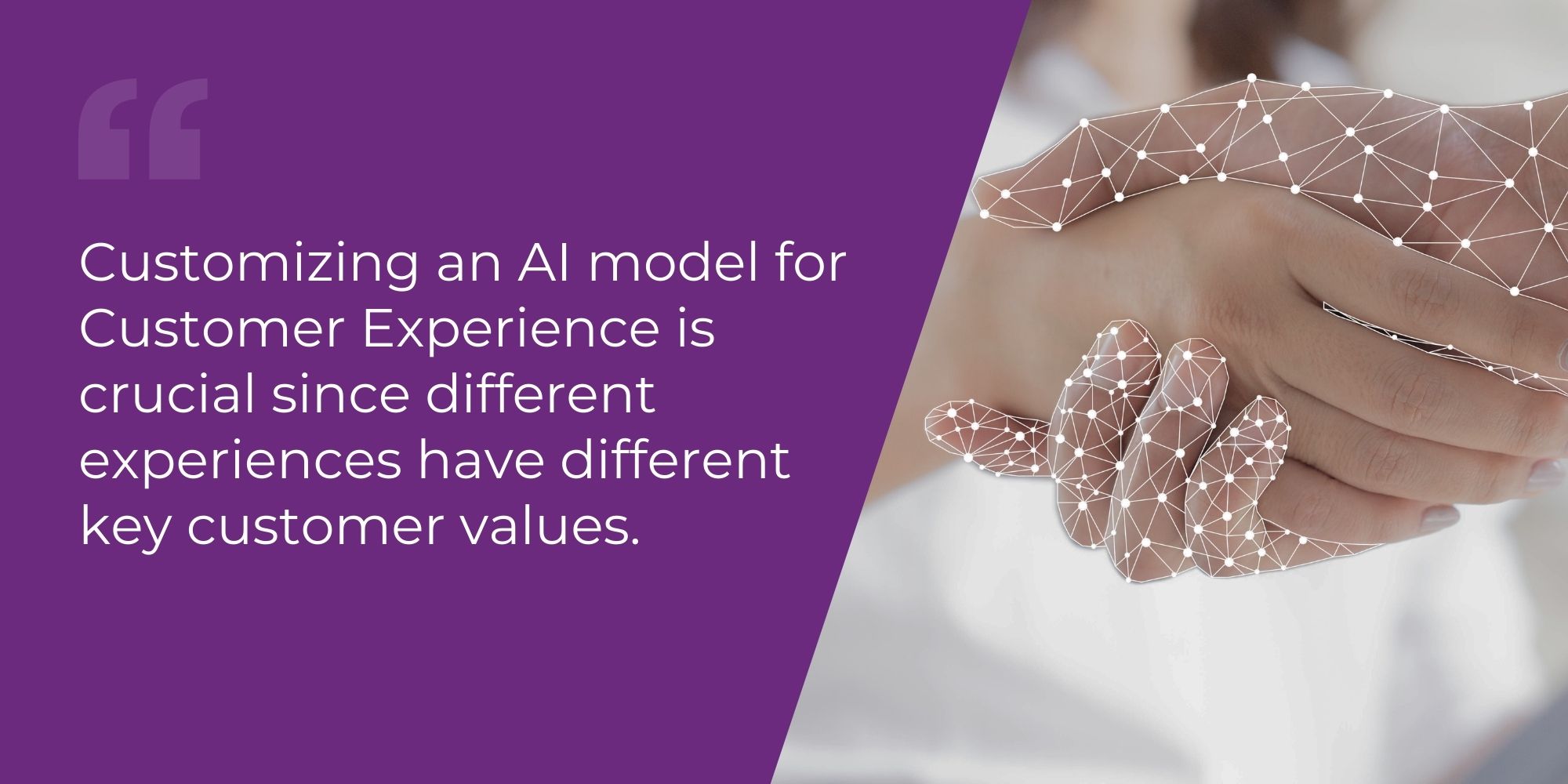Learn more about Colin Shaw: Join over 80,000 people on our LinkedIn Newsletter list or visit our website for more great podcast episodes.
Listen to the podcast:
This has been created in partnership with NICE.
AI is a massive new development in experiences. Unfortunately, it also creates enormous problems for organizations that don’t know what to do with it. Chances are you probably don’t either. Today, let’s look at how you can implement and enhance your experiences with AI.
I saw an ad that was impactful to me. It summarizes the mistakes many organizations make regarding AI implementation:
Elizabeth Tobey, Head of Marketing for Digital and AI for NICE /@NICE, an AI platform, recently joined us on the podcast. In this newsletter, I wanted to share her insight on this important technology and how it can work for your experience.
Tobey says that ChatGPT is a great place to start the AI discussion. For many of us, experiencing generative AI for the first time in late 2022 or early 2023 was an eye-opener for what is possible for customers and employees.
However, playing with ChatGPT didn’t give us the whole picture. In other words, Tobey says it was challenging for many people to understand how all the pieces of AI technology come together and connect to business systems from that one interaction. Instead, we are adding the technology to an existing tech stack without considering how it will all work together.
I couldn’t agree more. You will recall how I always say that organizations must step back and contemplate the experience they want to deliver. I want them to consider the customer and what is happening versus where they want to go. In my experience, companies that undertake experience design projects rarely do this ahead of time and instead, throw themselves headlong into the project without fully understanding how the experience design depends on knowing this.
Tobey thinks half of her current job has been education about determining the most impactful starter use case for AI rather than trying to implement everything simultaneously. In addition, she works with people to ensure that they have key performance indicators (KPIs) in place so they know whether that starter use case is working after deployment. Tobey says that the wide suite of solutions on the NICE platform facilitates this discovery process…well, nicely.
However, another part of the discovery process is investigating where the company’s pain points are. The NICE team determines where to focus based on the company’s problem statements. One of their AI Models is Enlighten XO, which stands for experience optimization and identifies these areas where the most impactful applications of automation and digital self-service could occur.
For example, if the contact center is overloaded, the team might suggest a self-service flow to address that. Or if the employees are juggling too much, the NICE team might recommend a co-pilot to help with that collaborative lift. Tobey says their depth and breadth of offerings and experience with AI facilitate this successful, solutions-based prioritization process for AI implementations.
The Change Management Aspect of Business
Tobey says that the siloed approach to implementations we first saw in the early days of the Web is present with AI as well. Avoiding that is difficult because it is part of change management. Many businesses, some of them very large global companies, have siloes forming right now regarding AI. She recalls a meeting where she had heads of departments from the same company in a room that had never met each other before.
However, that doesn’t mean companies should give up on efforts to break down departmental siloes in their organization. Tobey says eliminating siloes is crucial regarding knowledge management, which she describes as the heartbeat of what makes a successful enterprise great. Without knowledge management and all the content collected by all the departments from which to draw, AI cannot generate effective support for employees or customers.
Tobey says investing in a third-party solution is another significant part of success in implementing AI for a business. Few companies have the resources and expertise to handle an in-house AI implementation. In addition to the knowledge management challenges common among organizations today, it is difficult for a company to have employees with the specific skill sets needed to create AI models, train them, make them functional, and ensure their security.
By contrast, a company that offers a third-party solution has all the resources, talent, and expertise to do all those things. Additionally, third-party solutions can be further tweaked to reflect insight from the company’s data toward the company’s end goal. In other words, companies can customize third-party solutions.

Customizing an AI model for Customer Experience is crucial since different experiences have different key customer values. One experience, like booking a luxury (read: $$$$) vacation, might need to take more time to feel valuable to customers. Another, like replacing a broken or incorrect part, must be fast and easy to thrill customers. These different requirements to achieve value are far-flung, so having a flexible third-party solution that can work within a company’s system and meet its outcome goals is critical.
So, How Can You Sell AI within an Organization?
Tobey says a strong business case is the best way to convince an organization to commit resources to an AI implementation. She also thinks it’s essential to remove AI from the conversation. Instead, she would have AI advocates discuss the implementation’s objectives.
For example, one of NICE’s customers wanted to free up their triage team to tackle other strategic projects rather than tying them up in the call center with troubleshooting customer problems. Moreover, the company wanted to reduce inbound call volume significantly.
The NICE team listened to the pain points. Then, NICE made suggestions that addressed those pain points and ways to measure whether the solution was working and driving an impact.
NICE’s team didn’t focus on the specific AI tool in that discussion. Instead, they focused on the solution to the pain points.
Tobey says this example was one where their self-service option, autopilot, was the best solution. Not only did the NICE team succeed in reallocating the triage team to handle different projects, but they also reduced the company’s inbound call volume by a higher percentage than their client’s goal.
I love this example. Understanding and attacking the problem from a business perspective is key when persuading your organization to commit resources to a project. Additionally, the NICE team built credibility by approaching the client with a solution, which makes the client more likely to call the NICE team again with their next problem.

I was on the business end of implementing a new system in a large company while working in corporate life. I was sure this solution would solve all my company’s problems and could help us achieve world peace while making coffee for us in the morning. Not surprisingly, it didn’t; my expectations were unrealistic. I worry that some organizations have the same unrealistic expectations about AI.
Tobey says managing expectations regarding AI’s capabilities is still essential today, but enterprise-level AI is exciting. While it’s still early in developing that type of AI application, NICE keeps hearing from clients and prospects about potential AI applications. These conversations point the team toward new solutions, models, and products that continually push them forward.
For example, the team recently announced they would add data memory to Learning Management Systems to allow interactions to pause and pick back up at that point upon re-engagement. The year prior, this function was not the team’s focus, but this year, it was. Next year it will be another new thing, and so on.
These improvements and additions will continue as AI at the enterprise level matures. It’s not hard to imagine a future where you could ask AI to tell you how to sell AI within your organization.

So, What Should You DO About AI Implementation?
Tobey has a few suggestions about where an organization should start. First, getting a clear idea of what success looks like to you is essential. Then, a company can have a meaningful conversation where you can feel confident they understand what you want. Plus, they can provide solutions, products, and implementations that match that rather than first discussing their products’ prowess and feature set.
Tobey also suggests you give them at least some of your data if possible. Then, the partner can show you what they can do and how it works. This approach has been successful for their Copilot product. When prospective clients see how it works with their actual data and the rules within their brand, it shows them what they can realistically expect in implementing it in their business.
However, everyone must understand that AI alone cannot solve all a company’s problems. Computers didn’t, and the Worldwide Web didn’t, either. Both created new issues for the ones they solved. AI will, too.
Technology changes quickly, and sometimes, we forget how fast it happens. Tobey says the same thing is going to happen with AI.
She compares the state of AI today to the progression from a landline on your desk to the tiny computers (Aka, Smartphones) we carry in our pockets. She says it wasn’t long ago that she had to go to that office every day because that’s where her computer was and where her phone rang. Today, that sounds ridiculous. We have all that capability in our smartphones and routinely handle business from wherever we are as needed.
Therefore, it is essential to determine which AI solution matches your needs and works with your existing technology, culture, and business. Not all AI will be perfectly applicable to every business case. Having a partner who can tell you what will work, the parameters, and the success metrics and work with you to create a solution is essential.
Moreover, the partner is invested in your success, she says. It doesn’t behoove the supplier to sell something that falls on its face. The client will cancel after a year. Building relationships and piling up the winning objectives propels suppliers forward and allows them to continue to grow. Tobey says that finding a company with that mindset—who works on the technology with you and has something ready that will fit you now—is important.
This idea is similar to Customer Experience. Many people think they know what it is and how it works, and they do. However, they don’t get the details.
With AI, something similar happens. People try ChatGPT and think they get where AI is going. They do, but not in detail. However, in these nuances, the nitty-gritty details, one discovers the value.
Moreover, what value is to a marketer, a salesperson, a product person, a customer support person, or an ops person is different. Tobey says that is because they have different use cases. Therefore, working with people in the organization to discover where they are in the mindset regarding AI is essential to making the conversation work.

If you have a business problem that you would like some help with, contact me on LinkedIn or submit your pickle here. We would be glad to hear from you and help you with your challenges.


